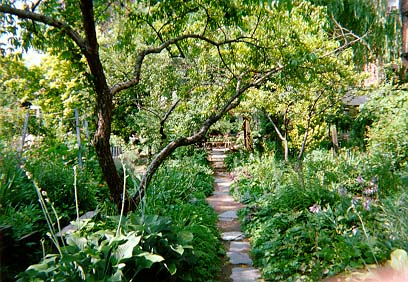
7/24/2000 NY NY
DAVID ZAGA: GARDENS OR HOUSING
Real estate prices in NYC are going through the roof. The market
has been so hot lately, that in the first 6 months of the year 2000 the average
price for apartments in Manhattan climbed by 50% compared to the same time period
in 1999. According to officials at the Douglas Elliman brokerage agency; the
average price for an apartment between southern Harlem and the Wall Street area
rose above the $800,000 mark during the second quarter of the year 2000. Some
buildings, like 515 Park Avenue, are being sold at the incredible price of $3,000
per square foot. These prices are prohibitive for the great majority of New
Yorkers. Many people who want to live in Manhattan simply cannot afford to rent
or buy in this city. This problem is caused because there is simply not enough
supply of housing units in the city to meet the demand. Statistics show that
from 1981 to 1999 there was an influx of 350,000 people into the city but there
was only 42,000 new rental apartments constructed. Drastic measures are needed
to correct this problem. The city of New York owns many parcels of land, and
since the real estate market is in great shape it should sell as many parcels
of land as possible to private enterprise for the development of housing units.
Many of the parcels of land that the City of New York owns are Community Gardens.
And even though these gardens serve a special purpose to the community where
they are located, they should none the less be sold to the highest bidder for
the development of more housing units. 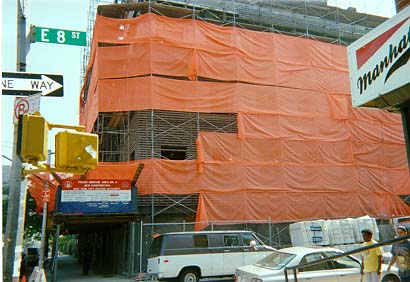
In one particular instance a community Garden called "Esperanza", which was located at 223 East 7th street, was sold to a development company called BFC Construction. BFC Construction wants to build on the land where the garden once stood and the community has risen against the development plan. The basic problem that the people from the East village are asking is whether the lot should be kept as a community garden or whether private enterprise be allowed to develop the land to the fullest extent of the zoning laws?
In order to answer this question one must take into consideration the fact that all community gardens that are located in the East village used to be tenements. These tenements were either lost by fire or demolished since they were completely run down and abandoned. Then during the 1970ís the Park Department decided to create a program in conjunction with the communities to revive these abandoned lots. The program was called "Greenthumb" and it basically rented the vacant plots of land to interested groups who wanted to create community gardens. The program was developed under the assumption that the gardens had a month to month lease and that the city could terminate the lease whenever they needed the lots back again.
The story behind the "Esperanza" Garden is a very interesting
one.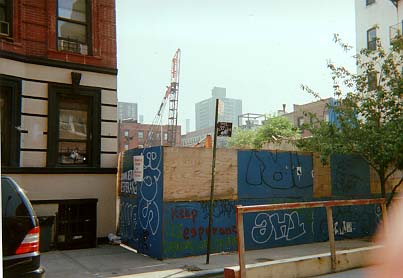 The Garden was founded 23
years ago by the Puerto Rican residents of the co-op next door. Some of the
original founders are still alive such as a lady by the name of Alicia Torres
who is now 76 years old. The gardeners enjoyed the use of the land without interference
of the City for many years. Then, during the month of April 1998, most of the
800 community gardens throughout the city were transferred from the Greenthumb
/ Parks Department Agency to the Housing Preservation and Development Agency.
The transfer of agencies placed the gardens under immediate threat for their
sale and development. In March of 1999, the lot underwent the intensive public
scrutiny required by the Cities Uniform Land Use Review Process. Under this
process, the local Community Board 3 held a hearing and approved the application
for the East Village project. During that summer, the city approved the plan
to sell the East seventh lot to The BFC Corporation. The project was reviewed
and approved by the Manhattan Borough President, Virginia Fields, and it was
forwarded to the City Planning Commission for its own approval. This project
was debated in the City Council and a deal was brokered with the help of Councilwoman
Margarita Lopez (D-Manhattan). The deal was that the City planning commission
would approve the sale of the lot in exchange of several concessions. One of
the concessions was that a nearby garden of 5,000 square feet would be permanently
preserved as a garden. Also a mural was preserved permanently, and 5,000 square
feet of space were given to the community, which is going to be administered
by the Gethsemane Garden Baptist Church.
The Garden was founded 23
years ago by the Puerto Rican residents of the co-op next door. Some of the
original founders are still alive such as a lady by the name of Alicia Torres
who is now 76 years old. The gardeners enjoyed the use of the land without interference
of the City for many years. Then, during the month of April 1998, most of the
800 community gardens throughout the city were transferred from the Greenthumb
/ Parks Department Agency to the Housing Preservation and Development Agency.
The transfer of agencies placed the gardens under immediate threat for their
sale and development. In March of 1999, the lot underwent the intensive public
scrutiny required by the Cities Uniform Land Use Review Process. Under this
process, the local Community Board 3 held a hearing and approved the application
for the East Village project. During that summer, the city approved the plan
to sell the East seventh lot to The BFC Corporation. The project was reviewed
and approved by the Manhattan Borough President, Virginia Fields, and it was
forwarded to the City Planning Commission for its own approval. This project
was debated in the City Council and a deal was brokered with the help of Councilwoman
Margarita Lopez (D-Manhattan). The deal was that the City planning commission
would approve the sale of the lot in exchange of several concessions. One of
the concessions was that a nearby garden of 5,000 square feet would be permanently
preserved as a garden. Also a mural was preserved permanently, and 5,000 square
feet of space were given to the community, which is going to be administered
by the Gethsemane Garden Baptist Church.
The gardeners who were not happy with the outcome of the deal sued the city to stop the development. On November 8, 1999, a state supreme court ruled that the gardeners had no standing to stop the development. This decision was immediately appealed by the plaintiffs to the appeals court in New York. Then, on November 16, 1999 the gardeners received a five-day notice informing them that they had to vacate the lot. At that moment in time, the gardeners organized themselves to stop the city from evicting them. The gardeners constructed a huge watchtower in the form of a frog to be able to monitor the police if they approached the garden. This huge frog, which was 13 foot high and 8 foot wide, was supposedly a "coqui". The symbolism for the choice of amphibian is hard to overlook. The thumb-sized frog is a native hero in Puerto Rico. There are many myths behind the frog and one of these stories tells a tale of a huge beast, which came stomping into a town one night terrorizing people. The coqui then jumped forward and with its famous chirping shrill cry scared the monster away. The gardeners placed a 24-hour watch inside the coqui, since it was designed to allow two people inside at the same time. The idea was to keep a constant watch for the police, and once the watchman saw the police approaching they would sound the alarms to have the supporting community impede the access to the garden.
The moment of truth came on February 15 2000. The city sent bulldozers and police to clear out the tiny community garden. At around 3:15 a.m. many protesters gathered themselves around the garden and they chained themselves to concrete blocks and fences in the hope of preventing the garden from being destroyed. The police then proceeded to tow away all the cars that were blocking their access. By 7:00 am the crowd of protesters had grown to around 150 people. At 10:00 a.m. the police officers converged and cut the protestors free from their chains and started carting them off to the local precincts. A total of 31 protesters were arrested as the police destroyed the garden with the help of the bulldozer, jackhammers and chain saws. It took about an hour to destroy the garden.
Out of frustration, the gardeners regrouped a week afterward and again clashed with the police. About 200 protestors stormed the empty lot shouting, " take back our gardens" while they were tearing down the fence. Eight arrests were made and people were charged with disorderly conduct and criminal trespass. Unfortunately seven officers and one demonstrator had to be treated for injuries at a local hospital.
Many public officials have involved themselves with the gardenersí
cause. Back in April of 1999, Public Advocate Mark Green sent a letter to the
Mayor of New York City, Rudy Guiliani, in reference to the Uniform Land Use
Review Procedure (ULURP) in connection to all the gardens that the city managed.
In this letter, Mr. Green urged to the Mayor to approve a bill, which was in
consideration in the assembly. The bill intended to change the ULURP procedures.
Mr. Green wanted to have the Mayor change the procedures to permit more community
input. He implored "¼ these parks already
exist ‚ now we have to grant them legal protection. Why squander this valuable
public asset when 20 years from now we may regret having sold off to the highest
bidder the few spaces some neighborhoods now have? 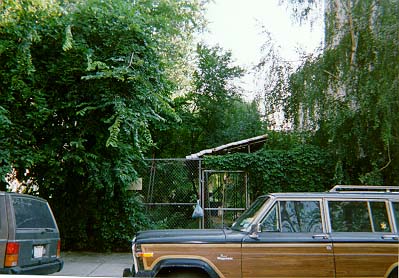
Other public officials also requested legislation to protect community gardens. The following are a few of the bills, which were introduced in 1999, with the intention to protect community gardens. On the State level there was Bill s.2127 which was intended to designate all the gardens as parkland. There was also Bill S.271, which wanted to make all gardens eligible for the Clean Water and Clean Air Bond Act funds in order to purchase and improve gardens. Some bills were also introduced on the city council level. For example Intro- 519, which was sponsored by council member Carrion, would have prevented the sale of all gardens by the city. Intro- 522, sponsored by council member Fisher, requested to amend the city charter to stop the sale of all gardens and required that their disposition be approved by the City Council. Lastly Resolution 631,which was introduced by both council members Carrion and Fisher, asked to revisit the ULURP (Land review) decisions. Although these bills were not specifically introduced to save the "Esperanza" Garden their approval would have stopped the destruction of the Garden. As protestors were trying to stop the police from destroying the garden they were also standing before a judge who was weighing in on the merits of the stateís case. Even Attorney General Eliot L. Spitzer was involved in the coordination of the lawsuit against the city. Although the judge was unable to issue an opinion before the city destroyed the garden, the judge did issue a temporary restraining order in which it blocked the city from moving against 174 other lots until the court meets again
After reading and investigating so much about the problem I proceeded
to take a first hand look at the gardens myself. It is easy to see that the
area has aroused the interest for development since I counted over 5 different
housing projects in the immediate vicinity of what used to be the Esperanza
Garden. (See photos numbered 1-6). Another interesting observation is that the
BFC Corporation has at least one other development on the area. What I had not
known and did not expect to see is the fact that the area is home to a large
concentration of community gardens, probably more than any other area in Manhattan.
The East village is also home to Tompkins Park, which spans a three-block area
and is beautifully maintained park. A great overview of all the community gardens
can be seen at the following web address: http://www.earthcelebrations.com/gardens/gardenmap.html.
According to the map some gardens have been demolished but there are still a
great number of gardens. 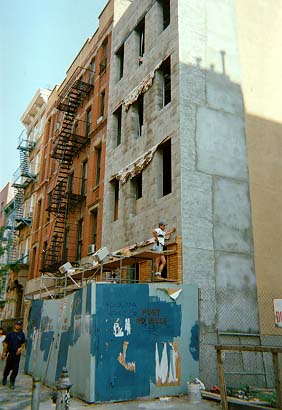
Since I read so much about the support that the community was given to the garden I proceeded to interview some the residents of the area. During my conversations I asked a series of 4 questions. The questions were 1) Did they live in the Area? 2) Did they know about the "Esperanza" Garden? 3) Did they approve of the construction that was taking place on what used to be the "Esperanza" Garden? And 4) Did they believe that all the surrounding Gardens should be preserved indefinitely? I was able to interview 20 people and the results from my survey were as follows; only 12 of the people I interviewed lived on the East village. Seventeen of the people had heard about the Esperanza garden. Eight said that they did not approve of the construction, while six said that they approved. Six people did not now enough to give an opinion. Only six people said that all the gardens should be preserved or protected against any development. Three people considered that all the gardens should be sold and developed. Eleven people, who are the great majority, insisted that they had to consider each garden on a case by case basis. What was most interesting about this survey was the fact that the people who showed the most passion were those who were in favor of the developing of the garden. Those who wanted to keep them as community gardens actually responded as if it was just an after thought. They did not show any passion to the idea that the gardens should be preserved. Most of the people who I interviewed were working not more than a block away from the garden. Those who wanted the gardens to be developed made such commentaries as " Fuck the gardens, they should build something so my kids can work on the building". Another comment was "they are pieces of shit". One lady commented that " well, if they keep them well kept, not like some of the ones Iíve seen; then I guess they should keep them as gardens". Another person said "they are nice but we do need more housing".
I wondered why nobody was actually inspired to talk of the importance of preserving the gardens, but the answer I believe lies as one visits those gardens. I was only able to view 15 gardens, and not coincidentally they were all padlocked. There simply was no access to the gardens. I was around the vicinity from 9:00 am to 1:30 PM and I had a chance to view many small children enjoy themselves during recess at Tompkins Park. Not one child was inside one of the gardens and I doubt whether they would have been permitted inside. Steven Vincent " who used to be an ex-member of Community Board #3ís Park Committee wrote in the NY Post that
" Most of the gardens are run as personal fiefdoms by one
or two people who keep them padlocked to keep the neighborhood people out".
I believe that the reason that I was not able to hear anybody fiercely talking
about protecting the gardens is due to the fact that the majority of the community
does not use the gardens. Another interesting note about my journey to the East
Village is the fact that I did not see even one piece of paper denouncing the
destruction of the garden. Although I visited the area 4 months after the gardens
were demolished, I had expected to see people voicing their anger over the destruction.
Like I said before not only did I not encounter anybody preaching for their
protection but also I did not see any flyers or propaganda in regards to the
matter. 
Although I found some gardens to be quite beautiful I believe that one has to consider the larger housing problem that the city has experienced. This project is intended to develop 79 family units. Although only 16 units will be set aside for low- income families; these will be 16 units that the city currently does not have. The gardeners insist that there are over 11,000 lots with vacant or abandoned buildings which the city can use to develop housing without the need to destroy gardens. Although the city should make every effort to encourage the development of those 11,000 lots that the gardeners point out to; it should be in addition to those housing units that are being constructed on top of what used to be community gardens. For several reasons, which may include tax breaks incentives, newly found interest in the East Village and the hope of a good return on their investment; developers have started to flock into the area. As long as the private sector is willing to invest in housing units the city should encourage their decision.
If people want gardens then they should go live outside the city; it is more important to provide the much-needed housing.
Alpern Andrew. New Yorkís Architectural Holdouts. Dover 1996 .
Bradford Landau Sarah. Rise of the New York Skyscrapper. Yale University Press
Department of City Planning . Zoning Handbook .Dept of City Planing 1990.
Homberger Eric. The Historical Atlas of New York City. Owl Books 1998.
Lank Edith. Modern Real Estate Practice in New York . Seventh Edition Dearborn. 1999.
Morrone, Francis. The Architectural Guidebook to New York City. Gibbs Smith 1998.
Ziga, Charles. New York Landmarks. Dovetail. 1998.
Zuckerman Howard. Real Estate Development. Prentice Hall. 1991.
Newspapers
Chivers C.J. The New York Times. Wednesday February 16, 2000 " After Uprooting Gardeners,
City Razes a Garden"
Chivers C.J. The New York Times. Monday March 6,2000. "Crowd Storms Former Garden to
Protest bulldozing by City"
Dyer John, New York Resident. July 4 ,2000. "Growing Concern Future of East Village
Comminity Garden"
Ferguson Sarah. The Village Voice. March 22-28, 2000. "Les is More".
Gest Emily. Daily News. Tuesday February 22,2000. "Lower E. Siders Vow to fight for
Garden".
Ingrassia Robert. Daily News.. Wednesday February 16,2000. " 31 Protesters Are Uprooted,
Arrested as City Garden is Razed".
Lambert Bruce. New York Times Sunday July 9 2000.PG 23. "Housing Crisis Confounds a
Prosperous City".
Lobbia, J.A. The Village Voice ,Tower and Tenements. November 24-30 1999. "The Coqui VS. The Bulldozer"
Mbugua, Martin, Thursday December 28 1999. "No Garden Party for Residents"
Roberts. T. Richard. Daily News. Thursady March 2,2000. " Making Way for More City
Housing"
Vincent Steven. The New York Post. Commentary "Gardeners VS the Poor".
Websites.
http://www.eathcelebrations.com/
Http://www.greenguerillas.com/
Http://www.nyclink.org/
Http://www.treebranch.com/savegardens/